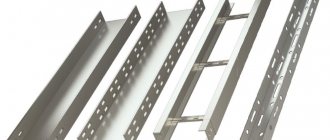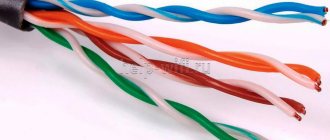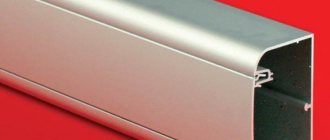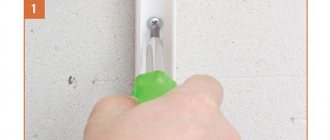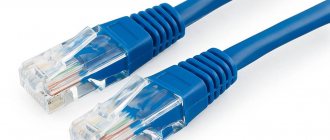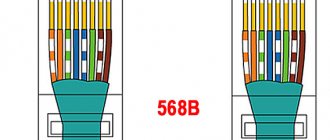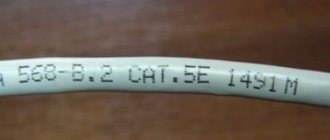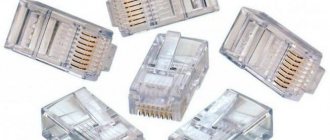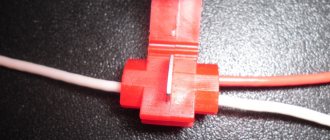Cable ducts are used for laying electrical wiring in rooms; the dimensions in the table allow you to quickly select the necessary components. Boxes are made of metal or plastic and can be painted in various colors. Manufacturers offer additional components for neatly going around corners or doorways in an apartment or office.
Standard sizes of cable channels - table
Product parameters and requirements for the construction of cable systems are regulated by the GOST 52868-2007 standard, but many manufacturers are guided by technical specifications during production.
The characteristics of cable channels for electrical wiring from the In-Liner company, having a rectangular or square cross-section, are given in the table.
Please note that when installing partitions, the compartments have different areas.
| Box dimensions, mm | Usable area, mm² | Allowable number of separators, pcs. | Number of compartments when installing partitions, pcs. |
| 25x30 | 568 | Not provided | 1 |
| 60x40 | 1767 | 1 | 2 |
| 80x40 | 2645 | 2 | 3 |
| 120x40 | 3840 | 4 | 5 |
| 100x60 | 5063 | 2 | 3 |
| 120x80 | 8510 | 4 | 5 |
| 200x80 | 14430 | 6 | 7 |
Selecting cable cross-section based on current strength: calculation formula
The amount of current passing through a conductor depends on the length, width, resistivity of the latter and on temperature. When heated, the electric current decreases.
1️⃣ First step. The calculation is carried out in exactly the same way, that is, first the total power of all electrical appliances that can be connected to the network is calculated:
Psum = (P1 + P2 + .. + Pn) × Kс
- P1, P2 .. – power of electrical appliances, W;
- Kc – demand coefficient (probability of simultaneous operation of all devices), default is 1.
2️⃣ Second step. Then the rated current in the circuit is determined:
I = Psum / (U × cos ϕ)
- Psum – total power of electrical appliances;
- U – network voltage;
- cos ϕ – power factor (characterizes power losses), default is 0.92.
3️⃣ Third step. At the last stage, the same tables are used, according to the PUE (Electrical Installation Rules), which are located above.
What does the cable channel look like?
The classic design consists of:
- a box-shaped base (with a rectangular, triangular or shaped profile), which is attached to the surface with screws or glue;
- a cover equipped with elastic hooks for fixing with mating flanges on the base;
- connecting elements that allow you to assemble a single highway from several channels;
- adapters for contouring external or internal corners;
- removable dividers, which are offered for boxes with increased width;
- block for installing sockets (used only on some types of channels).
An industrial tray consists of side guides and crossbars connected by arc welding, rivets or bolts. There are holes for mounting. The structure is placed on brackets pre-fixed to the wall.
The tray ensures that cables are held at a given height. The design does not provide protective covers.
Types of cable channel
Various types of cable ducts are designed for domestic, commercial or industrial use. Products differ in size, type of installation and load-bearing capacity. When arranging open electrical wiring, different types of channels are used (for example, depending on the number and cross-section of the cables being laid).
Skirting
The box is placed at the junction of the wall and the floor. The product looks like a standard plinth with a removable strip. The cavity located inside is suitable for installing thin telephone cables or twisted pair cables. The elements have a length of 2.5 to 3 m and are equipped with connecting strips and overlays for external or internal corners. The shade is selected depending on the type of coating on the floor or walls.
Floor-standing
The boxes for laying electrical wiring, designed for floor mounting, are distinguished by a height reduced to 10 mm and a spherical lid. The products are made from impact-resistant PVC plastic in different colors or aluminum alloy with anodized coating. For industrial premises, boxes are available with a height of up to 60 mm and a width of up to 100 mm. The hemispherical lid allows you to transport trolleys and does not create obstacles for the movement of personnel.
Inside the box there are several cavities for laying wires, separated by partitions.
Parapet
Cable channels are designed for installation on the walls of premises. Additional adapters allow you to join boxes or go around corners. Parapet products are used in residential or office premises for power supply wires or connecting equipment (for example, air conditioning units). They have a rectangular cross-section ranging from 80x40 to 120x60 mm. In addition to the standard white color, components are available with other shades or decorative coatings that imitate wood or stone.
Form
At first, manufacturers produced U -shaped profiles in gray and white, as well as rectangular ones. Now there are boxes of different colors and shapes.
Profiles are made in the form of a hemisphere or triangle. It all depends on the room in which they are laid. The type of finishing materials plays an important role.
Cable channels are made of non-flammable PVC or polyethylene.
The standard length of the segment is 2 meters.
But you can find a longer piece.
are products with a cross-section in the shape of the letter P. They are made with perforated or blind sides.
Scope of application of the cable channel
A novice installer should know what a cable duct is needed for. Plastic or metal boxes with a lid are used for laying power or low-current wiring in residential or office premises. Installation of structures on the facades of buildings is allowed, provided that protection is provided against the penetration of rain or melt water into the internal cavities. Open trays made of wire or steel profiles are designed for laying thick power cables and are used in industrial environments.
Materials
For the production of products the following is used:
- Steel.
- Aluminum.
- Plastic.
Plastic cable ducts are especially popular today. They have optimal characteristics. Often such products are installed outdoors.
Aluminum models have optimal fire resistance properties. They are used in factories and enterprises.
Metal products impress with a rich selection of colors. High-quality galvanized steel is coated with a coating that prevents corrosion. If the base is perforated, installation is greatly simplified.
Plastic channels come in different shades: white, light, colored, wood.
Specialized channels are used in different areas. This is due to the wide selection of accessories for performing the work: connecting corners, external and internal corners.
Today, many companies make and sell boxes. The most famous:
- Ekoplast.
- Asko.
- Omis.
- Legrand.
Modern cable channels have many advantages. Elasticity and strength are guaranteed, as well as the most reliable connection. During production, a special self-extinguishing plastic is used. It is optimal for installing cables whose voltage is a maximum of 1000 volts.
How to choose a box for laying wires
Before selecting a channel, you should develop a preliminary design of the electrical wiring and determine the range of materials. Standard boxes are 2 m long and are supplied in packs. Their quantity per package varies from 9 to 100 pcs. It is also necessary to purchase the required number of connectors and corner transitions.
Material
For internal installation in residential premises, plastic boxes are suitable, characterized by their compact size and neat appearance. Metal products are designed for installation in basements or industrial facilities. Steel boxes can be used to route power supply cables between distribution panels on the same floor or inside a building.
Box color
The color of the material is selected depending on the decoration of the walls of the room. Manufacturers offer plastic channels in various shades. When exposed to sunlight, the pigment loses its brightness. Steel boxes have a galvanized surface and are rarely covered with a layer of enamel. Aluminum ladders are designed for workshop installation and are not painted during production.
Installation rules
The installation procedure depends on whether shaped products - corners, branches and plugs - will be used or not. If they exist, the manufacturer gives clear recommendations about what distance should be left for proper installation. They should be followed to the nearest millimeter. Then everything looks neat. We will talk about the basic rules for installing cable channels of the usual type below in more detail.
How to choose a size
If you decide to route wires into cable channels, first you need to decide what size they are needed. Dimensions are selected based on the number and size of conductors that will need to be laid and some reserve added for the future - so that if necessary, one or two more wires can be laid.
When choosing a size, you need to take into account the number of cables that will need to be laid
The number of conductors in a cable channel is not standardized. The main thing is to be able to close the lid without problems. A limitation may be the need for separate placement of power and low-current cables. In this case, select the cross-section so that there is at least a small distance between the groups of cables.
Installation procedure and features
According to the rules, wiring is laid horizontally and vertically; inclined installation is permissible only on stairs. In other cases, the rules are not deviated from when wiring is open. To obtain an even cut when installing plastic cable channels with thin stacks, use metal scissors or others, but the cutting edge must be sharp. Aluminum and metal trays are cut with a hacksaw. Thick plastic can also be cut with the same tool - there will be a smooth edge and the profile will not wrinkle.
If you need a piece of a certain length - for a outlet, for example, you need to cut it in this order: snap the lid, align the edge, apply marks on the lid and body at the same time. Then you can cut it separately. With this order, the length of both products will be the same.
Please note that when passing the corner, the lid is not cut into two parts, but only the side walls are cut so that it can be bent. Do not forget that when going around the outer corner, the cover should be longer than the tray; in this case, it is better to mark the places of cuts on it after the cable channel body is secured.
Rules for installing plastic cable trays
The cable channel is attached to a non-wooden surface using nails with a wide head (screws can be used), or to plaster or plasterboard walls using self-tapping screws. For installation on brick or concrete walls, installation with dowels is required. The fastening step of the fasteners is about 60-70 cm; at the ends of the profile and at the joints, the fasteners are installed at a distance of 3-5 cm from the edge.
If two pieces of cable channels are joined, the cover must be positioned so that the joints of the housing and the cover do not coincide. Otherwise, the joint will be too noticeable and an unevenness may form, which will further emphasize the joint.
Order of laying wires
We lay conductors in the mounted housings. To prevent the walls of the cable channels from sagging, we install supporting jumpers with some steps, and then snap the covers. At this point, the installation of wiring in the cable channels can be considered complete.
